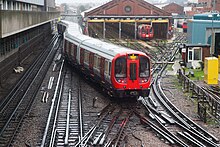 Hammersmith Depot in 2014 | |
 | |
| Location | |
|---|---|
| Location | Hammersmith, London, England |
| Coordinates | 51°29′52″N0°13′31″W / 51.4977°N 0.2253°W |
| Characteristics | |
| Owner | London Underground |
| Rolling stock | S7 Stock |
| History | |
| Opened | 1906 |
Hammersmith Depot is a London Underground depot in Hammersmith. It is situated between Hammersmith and Goldhawk Road stations on the Circle and Hammersmith & City lines.